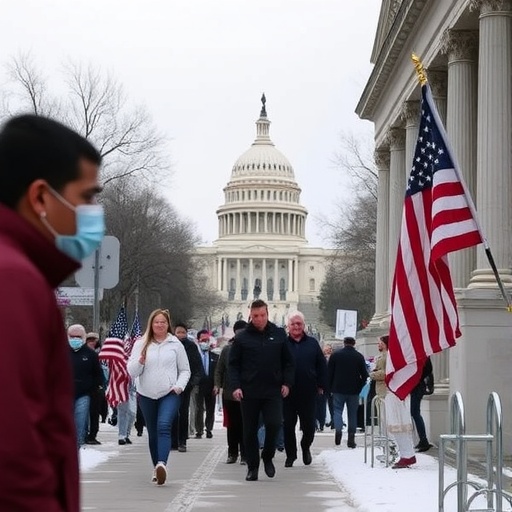Federal Workers Miss First Paycheck in Government shutdown Stalemate as Congress Drags Feet
In a stark reminder of the human cost of political gridlock, over 500,000 federal workers awoke this morning to empty bank accounts, marking the first full paycheck missed amid the ongoing Government shutdown now stretching into its third week. As Congress remains locked in a bitter stalemate, families across the nation brace for financial uncertainty, with no end in sight to the impasse over funding disputes.
- Federal Workers’ Heartbreaking Stories Emerge from Shutdown Chaos
- Congressional Stalemate Deepens: Key Players and Their Demands
- Economic Fallout Ripples Beyond Federal Paychecks
- Lessons from History: How Past Shutdowns Shaped Policy and People
- Path Forward: Negotiations Heat Up Amid Calls for Shutdown End
The shutdown, triggered by disagreements on border security and spending bills, has furloughed essential employees from agencies like the Department of Homeland Security, the IRS, and national parks services. While some workers are deemed essential and continue laboring without pay, the majority face immediate hardships, dipping into savings or relying on credit cards to make ends meet. “It’s not just about the money; it’s about the stability we’ve all worked so hard for,” said Maria Gonzalez, a 15-year veteran at the Environmental Protection Agency, who was furloughed last week.
Federal Workers’ Heartbreaking Stories Emerge from Shutdown Chaos
As the Government shutdown grinds on, personal tales of struggle are flooding social media and news outlets, painting a vivid picture of the toll on federal workers. Take John Ramirez, a TSA officer at Reagan National Airport in Washington, D.C. For 12 years, he’s screened passengers without fail, but now he’s working unpaid shifts while his wife, a schoolteacher, covers their mortgage. “We’ve got two kids in college, and this paycheck delay could mean choosing between groceries and tuition payments,” Ramirez shared in an interview with local reporters. His story resonates with thousands: the shutdown affects not just D.C. insiders but employees nationwide, from air traffic controllers in Atlanta to wildlife biologists in Yellowstone.
Statistics underscore the scale. According to the Office of Personnel Management, approximately 800,000 federal civilians are impacted, with 500,000-plus now officially without pay. Of these, about 380,000 are furloughed, meaning they’re sent home indefinitely until funding resumes. The rest—essential personnel—must report daily, accruing back pay but facing the anxiety of delayed compensation. A recent survey by the National Treasury Employees Union revealed that 40% of respondents have less than $1,000 in emergency savings, amplifying fears of cascading financial woes like missed rent or utility shutoffs.
Women and minority federal workers, who often head single-parent households at higher rates, are hit hardest. “This isn’t abstract policy; it’s real lives upended,” noted economist Dr. Elena Vasquez from the Brookings Institution. In cities like San Diego, where military support staff are prevalent, food banks report a 25% uptick in visits from federal families. One poignant example: a Coast Guard family in Miami, where the spouse of a furloughed mechanic launched a GoFundMe that raised $5,000 in 48 hours, highlighting community solidarity amid governmental failure.
Quotes from the ground level add emotional depth. “I joined the government to serve the public, not to beg for help,” lamented Sarah Lee, a Smithsonian curator sidelined from her research on American history. Her words echo the frustration of 2.1 million military reservists and contractors also affected, though active-duty troops received pay assurances last week—a small mercy in the broader crisis.
Congressional Stalemate Deepens: Key Players and Their Demands
At the heart of this government shutdown lies a Congressional stalemate that has paralyzed negotiations, with no scheduled sessions until at least next Tuesday. Republicans, led by House Speaker Kevin McCarthy, insist on tying funding to stricter border wall provisions, citing immigration surges at the southern border. “We can’t fund a broken system without reforms,” McCarthy declared during a press conference last Friday, referencing over 2.4 million migrant encounters reported by Customs and Border Protection in fiscal year 2023.
Democrats, holding the Senate majority under Chuck Schumer, counter that such demands are non-starters, pushing instead for a clean continuing resolution to reopen the government without policy riders. “This shutdown is a manufactured crisis by extremists who care more about optics than people,” Schumer fired back in a floor speech, pointing to the 2018-2019 shutdown’s record 35-day duration as a cautionary tale. President Biden has urged bipartisanship, stating from the White House, “Federal workers are patriots, not pawns in a political game,” but his appeals have fallen on deaf ears.
The impasse traces back to the mid-December lapse of a temporary funding bill, exacerbated by internal GOP fractures. Hardline Freedom Caucus members have blocked compromise votes, demanding deeper spending cuts. Meanwhile, Senate Republicans like Mitch McConnell advocate for a middle ground, but party unity crumbles under election-year pressures. A Congressional Budget Office analysis warns that each week of shutdown costs the economy $1.5 billion in lost productivity, with indirect hits to contractors and vendors pushing the figure higher.
Behind closed doors, whispers of exhaustion emerge. One anonymous House Democrat told Politico, “We’re all tired, but no one’s willing to blink first.” Public approval for Congress hovers at 18% per Gallup polls, with 72% of Americans blaming lawmakers equally for the stalemate. As holiday cheer fades, pressure mounts from constituents flooding Capitol Hill switchboards—over 10,000 calls daily, per clerk records.
Economic Fallout Ripples Beyond Federal Paychecks
The government shutdown‘s tentacles extend far beyond the immediate paycheck void for federal workers, threatening a domino effect on the U.S. economy. Small businesses near national landmarks, like those in D.C.’s tourist districts, report 30-50% revenue drops as parks and museums close. In Yellowstone, outfitters have canceled bookings worth millions, with one lodge owner estimating $200,000 in lost income. “We’re barely scraping by without the federal influx,” said Tom Hargrove, president of the Montana Outfitters Association.
Broader metrics paint a grim picture. The Conference Board projects a 0.1% GDP shave for the quarter if the shutdown persists, with consumer confidence dipping to its lowest since 2020. Stock markets have wobbled, with the Dow dropping 150 points last week amid shutdown fears. Food stamp programs, vital for 42 million Americans, face processing delays, potentially leaving 10% of recipients without benefits by month’s end, according to USDA estimates.
Contractors bear a heavy load too: firms like Lockheed Martin and Boeing, reliant on Defense Department funds, have furloughed 5,000 workers collectively. A Government Accountability Office report from past shutdowns notes that recovery takes months, with administrative backlogs costing agencies $100 million weekly in overtime to catch up. In border states like Texas, port closures have stalled $1 billion in daily trade, hammering exporters of agriculture and oil.
Experts like Mark Zandi of Moody’s Analytics warn of long-term scars. “Missed paychecks lead to credit score hits, which could linger for years,” he explained in a CNBC interview. Charitable organizations step in: the Capital Area Food Bank in D.C. distributed 20% more meals this week, while apps like Earnin advance wages to 50,000 federal users—up from 5,000 pre-shutdown.
Lessons from History: How Past Shutdowns Shaped Policy and People
This isn’t the first government shutdown, but its timing—post-holidays—amplifies the pain for federal workers. The 1995-1996 episodes, totaling 21 days under President Clinton, furloughed 800,000 and spurred public outrage that forced a budget deal. Similarly, the 2013 shutdown over Obamacare lasted 16 days, costing $24 billion and damaging Republican branding.
Patterns emerge: every Congressional stalemate since 1980 has stemmed from spending disputes, with Democrats decrying Republican brinkmanship and vice versa. The 2018-2019 record-breaker, at 35 days, saw federal workers receive back pay eventually, but not before 10 suicides linked to financial stress, per union reports. “History shows shutdowns end in exhaustion, not victory,” observed political scientist Dr. Lara Thompson from Georgetown University.
Key differences this time? Inflation at 3.1% erodes savings faster, and remote work norms post-COVID mean some furloughed employees juggle side gigs via platforms like Uber. Yet, resilience shines: during 2013, federal credit unions offered zero-interest loans to 100,000 members. Today, similar aid proliferates, with the AFL-CIO’s emergency fund disbursing $2 million already.
Looking back informs the present: post-1995 reforms streamlined appropriations, yet stalemates persist due to polarized media. A Pew Research study finds 65% of voters now view shutdowns as routine dysfunction, eroding trust in institutions.
Path Forward: Negotiations Heat Up Amid Calls for Shutdown End
As the government shutdown enters uncharted territory, glimmers of progress emerge. Bipartisan talks in the Senate aim for a vote by January 15, potentially bundling funding with debt ceiling hikes to avert dual crises. House moderates, including 20 Republicans, have signaled willingness for a short-term bill sans wall funding, pressuring Speaker McCarthy.
President Biden’s team floats incentives: expedited back pay processing and economic relief for affected districts. Advocacy groups like the Partnership for Public Service lobby intensely, with CEO Max Stier stating, “Congress must prioritize people over politics.” Public campaigns, including #PayOurWorkers, trend on Twitter, amassing 1.2 million posts.
Economists predict resolution within 10 days to minimize damage, but risks loom: prolonged stalemate could trigger IRS refund delays, affecting 70 million taxpayers. For federal workers, resources abound—unemployment claims are processable in 38 states, and food assistance expands via waivers. Recovery plans include phased reopenings, with agencies like the FDA prioritizing drug approvals to stem health risks.
Ultimately, this crisis tests democracy’s resilience. As one federal worker put it, “We’ll get our paycheck eventually, but the trust? That’s harder to restore.” With eyes on Capitol Hill, the nation watches for a breakthrough that restores normalcy and safeguards the public servants who keep America running.









